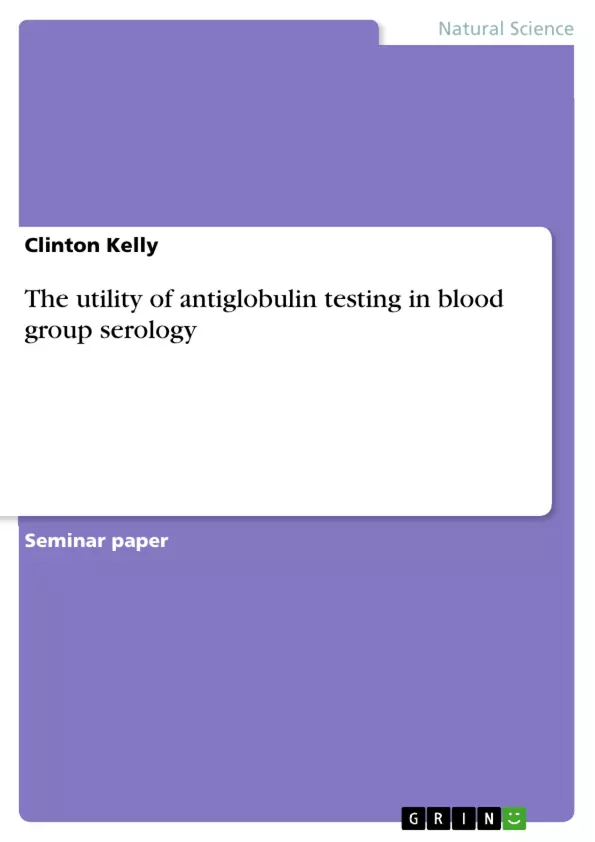The detection of reactions between antigen and antibody has been used to “phenotype” cells and to establish the presence of either antibody or antigen. Blood group antigens are either IgG or IgM. Though divalent, the IgG molecule is monomeric and the distance between two Fab regions is not generally enough to allow for direct agglutination. This therefore means that the detection of IgG reactions will have to be enhanced.
The most commonly employed techniques include the use of enzymes to cleave negatively charged particles on the surface of the red blood cells in order to reduce the negative charge and hence repulsion of the red cells. This then reduces the distance between cells and enables them to come together whence an agglutination reaction can be observed. Secondary antibodies may also be used to help in the detection of the reaction.
Apart from blood group serology, the detection of other human proteins which are capable of developing IgG antibodies and fixing complement can utilize this technique. Disease therapy monitoring in immunoglobulin therapies may also employ this technique.
The Antiglobulin Test Systems
Test systems that have been used in the detection of serological reactions can be classified into three broad categories namely
Liquid phase systems
This is the gold standard for detection of serologically significant reactions. The detection of reaction is by use of tubes or microtitre wells to visualize the reaction. There need be meticulous attention to the reactions and especially when the indirect antiglobulin test is performed and at the washing stage in particular.
Column agglutination systems
This simple column test allow for the use of glass beads or a gel system in six columns. The gel or microbead system is formulated to allow the passage of unagglutinated cells to the bottom but not agglutinated cells. A positive reaction is thus characterised by agglutinates at the top of the column and a button of free red cells at the bottom. Reagent IgM or Antiglobulin can thus be added to type the reaction without need for washing.
Inhaltsverzeichnis (Table of Contents)
- Introduction
- The Antiglobulin Test Systems
- Liquid phase systems
- Column agglutination systems
- Solid Phase
- The antiglobulin techniques and types
- The direct antiglobulin test
- The indirect antiglobulin test
- The Use of antiglobulin testing and reagents
- Blood Grouping
- Introduction
- Utility of Antiglobulin Testing
- Detection of haemolytic disease of the Newborn/foetus (HDN/F)
- Introduction
- Utility of Antiglobulin test
- Identification and screening of blood group system antigens/antibodies, Research and Education
- Introduction
- Utility of antiglobulin testing
- Detection and identification of transfusion reactions
- Introduction
- Utility of antiglobulin Testing
- Blood Grouping
- Other uses of antiglobulin testing other than blood group serology
- REFERENCES
Zielsetzung und Themenschwerpunkte (Objectives and Key Themes)
This work explores the utility of antiglobulin testing in blood group serology. It discusses the various types of antiglobulin tests, their applications, and their importance in different areas of blood group serology. The key themes explored in the text include:- The historical development and evolution of antiglobulin techniques
- The different types of antiglobulin tests and their respective mechanisms of action
- The applications of antiglobulin testing in various blood group serology procedures, including blood grouping, detection of haemolytic disease of the newborn, and transfusion reactions
- The use of antiglobulin testing in research and education
- The potential uses of antiglobulin testing beyond blood group serology
Zusammenfassung der Kapitel (Chapter Summaries)
The introduction discusses the significance of detecting reactions between antigens and antibodies in blood group serology, particularly the need for enhanced detection of IgG reactions. It highlights the use of enzymes and secondary antibodies to facilitate agglutination. The section on "The Antiglobulin Test Systems" categorizes these systems into liquid phase, column agglutination, and solid phase systems. Each category is described in detail, outlining its advantages and disadvantages. The "The antiglobulin techniques and types" section delves into the different types of antiglobulins available, including anti-IgG, anti-complement, and anti-IgG anti-complement. It also explains the two main types of antiglobulin testing: direct and indirect. The "The Use of antiglobulin testing and reagents" section focuses on various applications of antiglobulin testing in blood group serology. It addresses the use of antiglobulins in blood grouping, detecting haemolytic disease of the newborn, identifying transfusion reactions, and research and education.Schlüsselwörter (Keywords)
The primary keywords and focus topics of the text revolve around blood group serology, antiglobulin testing, direct and indirect antiglobulin tests, blood grouping, haemolytic disease of the newborn, transfusion reactions, research, and education.- Quote paper
- Clinton Kelly (Author), 2013, The utility of antiglobulin testing in blood group serology, Munich, GRIN Verlag, https://www.grin.com/document/271700



